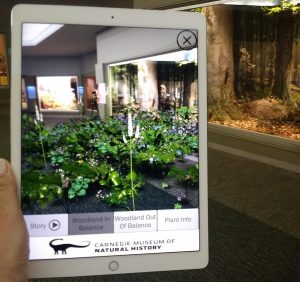
Maria C. R. Harrington Ph.D. is an American information scientist and artist. She is an Associate Professor of Digital Media at the University of Central Florida and leads research projects focused on methods of modeling and visualizing natural environments and their use in immersive informal learning application design, development, and evaluation. She uses methods of geospatial data visualizations in Unreal Engine to create immersive embodied experiences using augmented (AR) and virtual reality (VR). She has deep expertise in human centered design, and is an expert in project management, strategy, research design, and team building.
The Harrington Lab at UCF investigates virtual nature, using AR and VR as a technical artifact, to better understand perceptual phenomenon as it relates to human-computing-environment interactions that cause emotional, learning, and aesthetic outcomes. The lab is highly collaborative with several active multidisciplinary partnerships.
- Find publications on Google Scholar
- The Harrington Lab: VirtualNature.org
- Download software: https://the-harrington-lab.itch.io/
- Epic Games Unreal Engine Marketplace Plants
Research
She has been PI or co-PI on research, teaching grants, and fellowships totaling over $130,000. She is a recipient of the UCF Excellence in Research Award, UCF Foundation GAP Fund Award 2022, Association for Educational Communications and Technology Learner Engagement Division Outstanding Digital Learning Artifact Award 2021, Epic Mega Grant Award 2020, Museum and Web MW21 and MW20 GLAMi Finalist Award, UCF Office of Research & Commercialization VPR Advancement of Early Career Researchers 2019 Award, and The Carnegie Museum of Natural History 2018 Powdermill Artist in Residence Fellowship Award.
She has published over 35 peer-reviewed papers in international journals and conference proceedings including Frontiers In Virtual Reality, Springer Nature Virtual Reality, IEEE Transactions on Learning Technologies, Curator: The Museum Journal, Museum and the Web, NASA Human Research Program, HASTAC, Human Factors and Ergonomics Society, ACM SIG CHI, ACM SIG IDC, ACM SIGGRAPH, and IEEE Virtual Reality and 3D User Interfaces. She has been invited to review grants for the NSF, and the Canada Foundation for Innovation, and is an Editorial Board Member for Springer Nature Virtual Reality Journal.
Research Projects
Below are images from research projects by Dr. Harrington:
The AR Perpetual Garden App
The AR Perpetual Garden App (Figure 1) was developed in 2016 as a virtual diorama and I updated all of the plant models as part of an Epic MegaGrant 2020 award and a Carnegie Museum of Natural History, 2018 Powdermill Artist in Residence Fellowship. As one of the first AR apps to use the Unity game engine and SLAM technology (ARCore and ARKit SDKs), it visualized a spatial 3D forest understory supporting high information fidelity, high immersion, and embodiment in the design. Accurate bioacoustics were used for a redundancy cue and to enhance immersion. Interactivity was supported with access to the audio story and a website with facts and concepts. The illusion was striking, as a virtual forest appeared to cascade out of the real diorama to cover the gallery floor, effectively transforming the dark room into a virtual woodland springtime bloom. High presence was reported in the experimental study, as were emotional and learning outcomes. Two data visualizations were created from data so the visitors could walk around and experience “Woodland in Balance” in contrast to “Woodland out of Balance.” It received the 2020 Museum and Web International Conference, MW20 GLAMi Award, Finalist in Exhibition Media or Experience: Immersive Media (AR/VR/Environmental) and the 2021 Association for Educational Communications and Technology (AECT), Learner Engagement Division, Outstanding Digital Learning Artifact Award.
Main research findings and outcomes, (N = 56)
- Learning behavior was observed to be very different between AR and No-AR conditions, subjects acted like they were in a real field of flowers, not a museum
- Actual learning and dwell time were the same in both conditions, but perceived learning ranked higher in the AR
- Presence, engagement, excitement, and emotional ranks were higher in the AR
- Facts and story were significantly correlated to actual learning, and the immersive visualizations, plant models, and bioacoustics were correlated to the story, showing complex relationships in the design factors and justification of use for learning outcomes
- However, ease of use and plant models were correlated to perceived learning and not to actual learning outcomes, showing the importance of research design, methods, and measurements, in informing the design of AR learning applications and generalization

The Virtual UCF Arboretum
The Virtual UCF Arboretum (Figures 2, 3, and 4) was developed in 2016 as a model and geospatial visualization of the real UCF Arboretum. It is in use for several ongoing research projects. It relied on ESRI GIS data sets to visualize a set of native plants and flowers to represent 100 hectares (247 acres) of the real UCF Arboretum in Epic Games Unreal Engine. It achieved high information fidelity in the accuracy of plant models, inventory, and plant population distribution data, and high graphical fidelity with photorealistic detail representative of the real environment. Accurate bioacoustics, insect, bird, and fish avatars were added, and all models are interactive with educational content. The website companion product is in use on PBS Learning Media and has been aligned with STEM educational standards. It works in VR headsets and has been integrated with an Infinadeck omnidirectional treadmill in partnership with a local startup M3DVR.
It has received numerous awards and honors: UCF Research Foundation GAP Fund Award 2022, ACM SIGGRAPH 2023 Electronic Theater 50th Year Retrospective Celebration, The Virtual UCF Arboretum (Invited), 2022 University of Central Florida, College of Sciences, Excellence in Research Award, 2022 University of Central Florida, Nicholson School of Communication and Media, Outstanding Creative Activity Award, 2021 Museum and Web International Conference, MW21 GLAMi Award, Finalist in Resources for Scholars and Researchers Category, Epic Games Epic MegaGrant 2020, and the 2019 UCF ORC VPR Advancement of Early Career Researchers (AECR) Grant. Currently, it is being updated with Epic Games Unreal Engine 5 and Reality Capture to enhance realism to be indistinguishable from the real in the level of detail and complexity.
Main research findings and outcomes: Pilot study, (N = 15)
- No cybersickness in the omnidirectional condition, cybersickness in VR headsets
- Evidence of engagement from subjects willing to stay beyond 1 hour
- Evidence of presence:
- The illusion of walking up and down small hills is believable, even though the treadmill is flat
- Illusion of temperature differential, feeling hot, even though subjects were inside an air-conditioned room
- Showing fear near the water, no danger of a real alligator
- Outcomes on learning gains: (low statistical power so results are not conclusive)
- 40% learning gains in all conditions, desktop, VR headset, and Omnidirectional treadmill, but distributions were very different
- Learning outcomes in the desktop showed a normal distribution with almost no variance, one outlier of interest
- VR headset distribution was skewed upwards towards 100%
- Very strong correlations between learning outcomes and emotional reactions, as expected much higher for the Omnidirectional treadmill condition



Important Publications
- Marin, F. E. Jr. and Harrington, Maria C. R. (accepted 2023). “Learning and Emotional Outcomes in an Immersive Omnidirectional Pilot Study,” 2023 Interservice/Industry Training, Simulation, and Education Conference (I/ITSEC)
- Harrington, Maria C. R. (2023). Virtual Nature Makes Knowledge Beautiful. Frontiers in Virtual Reality, 4. 1100540. DOI=10.3389/frvir.2023.1100540
- Harrington, Maria C. R., Jones, Chris, and Peters, Crissy. (August, 2022). “Course on Virtual Nature as a Digital Twin: Botanically Correct 3D AR and VR Optimized Low-polygon and Photogrammetry High-polygon Plant Models.” ACM Special Interest Group on Computer Graphics and Interactive Techniques Conference 2022 Courses (ACM SIGGRAPH 2022 Courses), Virtual Event, USA, August 7 – 11, 2022; ACM: New York, NY, USA. DOI 10.1145/3532720.3535663.
- Harrington, Maria, C. R., Bledsoe, Z., Jones, C., Miller, J., and Pring, T. (2021a). Designing a Virtual Arboretum as an Immersive, Multimodal, Interactive, Data Visualization Virtual Field Trip. Multimodal Technologies and Interaction, 5(4), 18. doi:10.3390/mti5040018
- Harrington, Maria, C. R. (2008). Ph.D. Thesis: Simulated Ecological Environments for Education (SEEE): A Tripartite Model Framework of HCI Design Parameters for Situational Learning in Virtual Environments Available on D-Scholarship@Pitt http://d-scholarship.pitt.edu/8971/
Other Significant Publications:
- Harrington M, Tatzgern M, Langer T, Wenzel J. Augmented Reality Brings the Real World into Natural History Dioramas with Data Visualizations and Bioacoustics at the Carnegie Museum of Natural History. Curator: The Museum Journal. 2019 April 19; 62 (2):177-193. Available from: https://onlinelibrary.wiley.com/doi/abs/10.1111/cura.12308 DOI: 10.1111/cura.12308
- Harrington M. The Virtual Trillium Trail and the Empirical Effects of Freedom and Fidelity on Discovery-based Learning. Virtual Reality. 2012 June 01; 16(2):105-120. DOI: 10.1007/s10055-011-0189-7
- Harrington M. Empirical Evidence of Priming, Transfer, Reinforcement, and Learning in the Real and Virtual Trillium Trails. IEEE Transactions on Learning Technologies. 2011 April; 4(2):175-186. DOI: 10.1109/TLT.2010.20
- Harrington, Maria, C. R. (2009). An Ethnographic Comparison of Real and Virtual Reality Field Trips to Trillium Trail: The Salamander Find as a Salient Event. In Freier, N.G. & Kahn, P.H. (Eds.), Children, Youth and Environments: Special Issue on Children in Technological Environments, 19(1), 74 – 101. https://www.jstor.org/stable/10.7721/chilyoutenvi.19.1.0074? seq=1#page_scan_tab_contents
- Harrington M. University of Pittsburgh, U.S. Provisional Patent Application Serial No. 60/816,357 “Simulated Ecological Environments for Education and Methods of Creating and Implementing Same” (June 23, 2006)